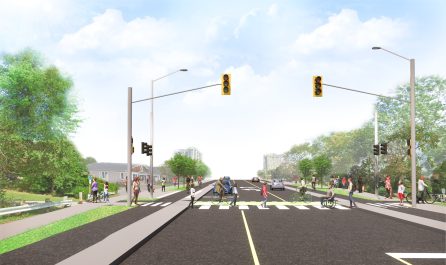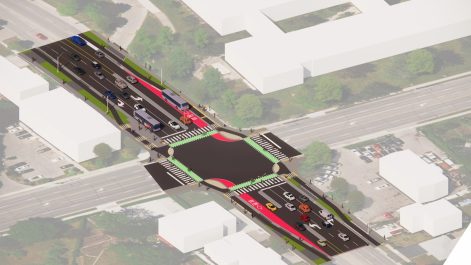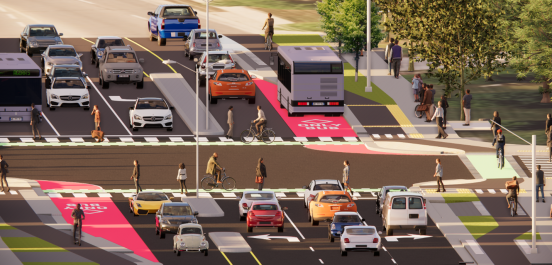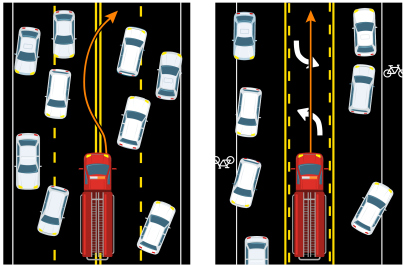Safety designs
Hundreds of people use the Applewood Trail daily, including people along Bloor Street and in the surrounding neighbourhoods. These people need a safe and easy crosswalk to get across Bloor Street.
We will be adding a new mid-block, signalized pedestrian crossing at Applewood Trail so people can cross the street safely.

Intersections will also have better ramping, tactile warning plates, improved signage and markings that meet the Accessibility for Ontarians with Disabilities Act requirements.
On Bloor Street we are adding cycle tracks to the boulevard instead of bike lanes to the roadway.
Bike lanes are integrated with the roadway while cycle tracks are separated from the roadway.
This is a main corridor and a place where cyclists – both recreational and commuter – should be able to ride safely. Plus, there is a direct connection to the Applewood Trail, which will allow people to travel through our community on their bikes safely.
Adding cycle tracks to Bloor Street will allow and encourage more people to get on their bikes and ride instead of using the car. You can still drive, if you want, but you will have the option to ride your bike too.
Cycling connections
Dedicated cycling infrastructure that is physically separated from traffic makes connections safer and more comfortable for everyone, regardless of age or ability.
The new cycle tracks along Bloor Street will provide direct connections to Applewood Heights Secondary School, Applewood Hills Plaza, Fieldgate Plaza, High Point Mall, the Mississauga Valley Community Centre, the Applewood Trail, the Chechalck trail, many parks and hundreds of homes.
In the surrounding Bloor Street area the connections and opportunities continue to grow with access to the Burnhamthorpe Community Centre, the Burnhamthorpe Library, the Hazel McCallion LRT, Mississauga City Centre including City Hall and the City Centre Transit Terminal, many more schools, shopping, parks, trails, jobs, and homes of friends and family.
Building protected cycling infrastructure along Bloor Street will help make Mississauga’s transportation network more equitable with safe access to necessities including food, services, education, jobs and community.
If you’ve ever ridden your bike in a live lane of traffic, or even in a painted bike lane, you know that it can be frightening. We’re working to change this in as many areas around the city where it makes sense to do so, including Bloor Street. We build protected spaces for bicycles so people feel safe to ride.
Streets and roads should be safe for everyone who wants to use them, whether you drive, take transit, walk or even bike. The City’s Cycling Master Plan aims to make Mississauga a bike-friendly city and build 900 km of bike infrastructure in the next 25 years.
If bike lanes are not protected and safe, most people won’t ride in them. Riding on the road beside cars, trucks and buses, without any protection, is not fun.
All around the world, when protected bike lanes are installed, more people ride in them. It doesn’t happen overnight, but over time, more people ride their bikes. We built roads to accommodate cars and we are doing the same with protected bike lanes.
We will install a number of safety measures, including:
- Accessible transit stops
- Better ramping, tactile warning plates, improved signage and markings that meet the Accessibility for Ontarians with Disabilities Act requirements
- Dedicated space (called crossrides) for cyclists to ride through intersections safely without having to get off their bike
- Narrower travel lanes to make drivers pay attention more and slow down
- New street light poles to make walking and driving at night safer
- Reduced curb radiuses at all intersections which slows traffic and makes it easier for drivers to see pedestrians
A big part of this project is to make the road safer for everybody.
Mississauga is committed to Vision Zero, which is our pledge to have zero injuries or deaths on our roads. We do this by lowering speeds and by protecting everyone who uses our roadways.
We know many people drive, but not everyone does. For those who don’t, they should still be safe on our streets.



